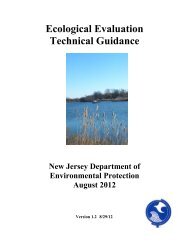Technical and Regulatory Guidance for In Situ Chemical ... - ITRC
Technical and Regulatory Guidance for In Situ Chemical ... - ITRC
Technical and Regulatory Guidance for In Situ Chemical ... - ITRC
Create successful ePaper yourself
Turn your PDF publications into a flip-book with our unique Google optimized e-Paper software.
Approximately 8,000 lbs. of ozone were injected into the subsurface over a 12-month period. <strong>In</strong><br />
general, effective ozone transport <strong>and</strong> ozone gas mass transfer to the aqueous phase were observed.<br />
Ozone concentrations ranging from less than 1 ppm to several hundred ppm were measured in soil<br />
gas over the entire area of the monitoring network. These concentrations were several orders of<br />
magnitude below the injection concentration of 5 percent (50,000 ppm), which reflects rapid<br />
subsurface ozone reaction <strong>and</strong> degradation. Dissolved ozone concentrations up to 1.4 ppm were<br />
measured in soil moisture samples collected from pressure-vacuum lysimeters.<br />
Soil samples collected at paired locations prior to in situ ozonation, <strong>and</strong> during February, June, <strong>and</strong><br />
Oct ober 1998 showed an average 93 percent reduction in PCP <strong>and</strong> PAHs. The maximum<br />
pretreatment soil contamination was reduced greater than 98 percent, from an initial value of 220<br />
mg/kg PCP <strong>and</strong> 5,680 mg/kg total PAHs, to below detection limits.<br />
Significant contaminant mass reduction was reflected not only in soils data, but also in substantial<br />
reductions in aqueous-phase concentrations of PCP <strong>and</strong> PAHs. The lysimeter data showed several<br />
orders of magnitude reduction in dissolved PCP <strong>and</strong> PAHs at the first sampling event, conducted<br />
aft er approximately one month of ozone injection in the 5-spot area. <strong>In</strong> addition, an individual<br />
lysimeter produced liquid NAPL at the beginning of the project but not after one month of treatment.<br />
Ozone consumption was calculated at approximately 7 pounds of ozone per pound of PCP <strong>and</strong> PAHs<br />
destroyed. This number is highly conservative, because the system was optimized <strong>for</strong> maximum<br />
ozone loading, <strong>and</strong> not <strong>for</strong> efficient ozone usage. Combining in situ ozonation <strong>and</strong> bioremediation<br />
can significantly decrease ozone consumption.<br />
Point of Contact<br />
Wilson S. Clayton, Ph.D.<br />
Aquifer Solutions, <strong>In</strong>c.<br />
28599 Buchanan Drive<br />
Evergreen, CO 80439<br />
(303) 679-3143<br />
wclayton@aquifersolutions.com<br />
7. San Francisco Bay Sites managed by the Cali<strong>for</strong>nia Regional Water Quality Control<br />
Board<br />
Five pilot- or full-scale applications of in situ chemical oxidation (using potassium permanganate<br />
or hydrogen peroxide) were per<strong>for</strong>med in 1999 at industrial sites in the San Francisco Bay area.<br />
The contaminants of concern included perchloroethylene, trichloroethylene, vinyl chloride,<br />
chloroethane <strong>and</strong> benzene. The soils at these sites are typical of the South Bay area, <strong>and</strong> consist<br />
of a mix of silts, s<strong>and</strong>s, <strong>and</strong> clay which is fairly tightly packed <strong>and</strong> there<strong>for</strong>e not particularly<br />
permeable. Direct-push injectors were used to deliver the oxidants to the subsurface. Pre- <strong>and</strong><br />
post-injection monitoring was per<strong>for</strong>med to evaluate the per<strong>for</strong>mance of the oxidants.<br />
Based on the results of the post-injection monitoring, which indicated either a significant<br />
rebound or negligible reduction of contaminant concentrations, the Regional Water Quality<br />
Control Board concluded ISCO was “ineffective” at cleaning up the groundwater at four of these<br />
sites, <strong>and</strong> “somewhat effective” at the fifth site. However, several aspects of these projects<br />
contributed to the poor per<strong>for</strong>mance of ISCO. First <strong>and</strong> <strong>for</strong>emost, the low permeability of the<br />
soils at the sites did not allow adequate dispersion of the oxidants or sufficient contact with the<br />
contaminants. It is likely that preferential flow pathways were the dominant method of transport<br />
of the oxidant, thus bypassing large volumes of the subsurface.<br />
B13
















